
Would you like to start a conversation with other industry leaders to brainstorm a challenge or to just know more on a particular topic?
Engage in online discussions with your Peers
Start Now“New problems demand new principles. Put bluntly, there’s simply no way to build tomorrow’s essential organizational capabilities—resilience, innovation and employee engagement—atop the scaffolding of 20th century management principles.” — Gary Hamel in ‘The Future of Management’
Indian Economy in the Global Context
As per IMF reports, India shall surpass China in 2016, as China’s economy is hit in the recent times. What started as a foreign exchange crisis was converted into a global opportunity, with more fundamental economic reforms since 1991 and their renewal in the 2000s. India has, thus, progressed towards a free market economy playing an important role in the global scenario.
The Indian Economy is the tenth largest in the world in nominal GDP terms and the third largest by purchasing power parity (PPP). The country is one of the G-20 major economies and a member of BRICS. As one of the leading economists says,“ the economic reforms post 1991 in India have converted the once lumbering elephant into the latest Asian tiger!”
This Indian economic growth has been driven by the expansion of services sector since 1991, and the growth in this sector that has been consistently faster than other sectors. The services sector now constitutes about 57% of the overall GDP. It is debated that the pattern of Indian development has been a specific one and that the country may be able to skip the intermediate industrialisation-led phase in the transformation of its economic structure. In many ways, the IT Revolution that is happening over the last 2 decades is basically another Industrial Revolution!
When set against the global context, the GDP of India in nominal terms compares as:
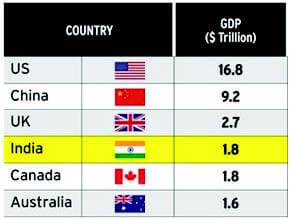
Source: World Bank Estimates for 2013
The above table vividly indicates that India is way behind China, and we need to continue to do things differently, like the 1991 reforms, to grow economically and socially
Will the services sector continue to be the engine for the growth in this digital world? How will the ‘Make in India’ strategy pull investments and generate employment in the manufacturing sector? How will a shift of labour occur from the dominating agriculture sector to other sectors? These are a few of the crucial questions that economists and politicians are grappling with and debating about.
Globally Relevant Indian Organizations
Gary Hamel, the management guru and the co-creator of the Theory of Core Competencies visited India last month and addressed some of the burning issues that India needs to address if we are to achieve $10 Trillion (5x times) growth in terms of nominal GDP. He highlighted that the focus areas for action have to be viewed in the global context and not just in the current context to remove what ails the Indian economy! Also, the actions have to consider the evolving future in the 21st century and not what we will do as of now.
Simply put, Gary’s singular focus is, are we becoming globally relevant, while enabling innovation that will work for India or the developing world?
Invited by the renowned leader Vineet Nayar, former CEO of HCL, Gary Hamel during his visit observed that the challenges for India Inc. include accelerating change, reducing barriers to entry across every industry, and managing rising expectations of consumers and employees. While he responded to several questions from the India Leadership community, he also posed a few questions to us to reflect, if India is keen to sustain the growth momentum in the global economy in the next decade:
- Is competitive advantage enough to survive in the new age economy?
- Are we going to be global benchmarks or not?
- Are we ready for leapfrogging old management practices?
- Are we embracing the digital economy?
- Are we looking for ways to innovate to open up opportunities for people in the developing world?
One of the key responses Gary gave in his interactions was “Today, any company has to build an evolutionary advantage. It is no longer enough to have a competitive advantage because those advantages disappear over time”. The question is, can we build organizations that change before they lose their competitive advantage and in time have an evolutionary advantage? How do we build an organization that can change as fast as change itself?”
Simply put, Gary’s singular focus is, are we becoming globally relevant, while enabling innovation that will work for India or the developing world?
Inertia to Innovation
First about innovation and then about inertia! This sequence is the best, if we want to change the way we work and the way we look at the future.
Organizational innovation happens in FIVE major value creating dimensions - Products/ Services, Business Models, Consumer Segments, Business Processes, and Capabilities.
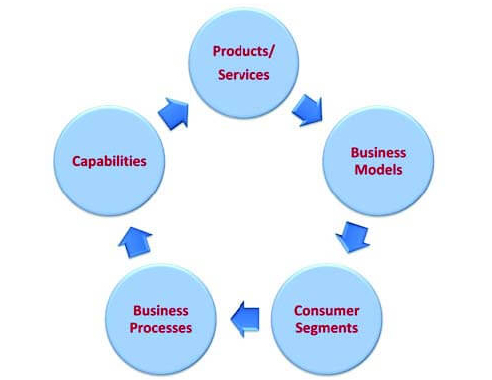
Over the last 2 decades, with the IT revolution, globalization and Internet economy, innovation has expanded beyond Products/Services and Business Models to Consumer Segments, Business Processes and Capabilities to build the ‘evolutionary’ advantage! All the five dimensions have a very strong strategic execution impact, on their own as well as in an interconnected manner on the overall organization within the business/ global environment. While the first three dimensions relate to the ‘outside-in’ impact of innovation, the last two – Business Processes and Capabilities- relate to the ‘inside- out’ impact of innovation.
Our focus here is on innovation relating to ‘Business Processes’ and ‘Capabilities’ and we will address these questions to the extent that they become relevant for our understanding, adoption and application, particularly in India. It is interesting to see the synergistic linkage between Business Processes and Capabilities, since one directly impacts the other. To be truly effective, Business Processes
need supportive innovation on Capabilities, while leadership and business-related capabilities can become effective only with redesigned business processes, to get the right focus and right freedom for people to operate and deliver on strategic objectives of evolutionary advantage.
Each of the above 5 questions has their reference in the context of Business Processes and Capabilities, as relevant to each one of us. We will first assess the ‘Inertia for Change’ and then consider the G Gary Hamel questions in the context of inertia and then attempt to share observations based on immense India experience in the Business Process Management and Capabilities space.
Now, we turn to Inertia! This term simply refers to the resistance of an object to any change in its motion, including speed and direction. In other words, it is about the ‘inertia for change’, and in our context, relating to Indian organizations, with specific reference to Business Process Management as well as Capabilities. Organizations accumulate inertia over a period of time, and it calls for ‘disruptive’ strategy to break free from the past!
Competitive Advantage to Evolutionary Advantage
Thanks to the powerful combination of globalization and technology revolution, Business Processes and Capabilities started changing globally through Off-shoring, Shared Services (Global In-house Captives -GICs), Outsourcing etc., This was initially due to cost/labour arbitrage for comparative advantage, and later to build ‘structured flexibility’ to business operations for an ‘evolutionary advantage’. From a strategic stand point, shared services/ outsourcing had commenced much earlier in countries like US/UK, as it freed up leadership time to focus on core business processes viz., risk management and decision support activities, while the two extremes of process value chain – transactional processing at the lower end and the knowledge based services at the higher end - were consolidated into Shared Services.
However, many organizations In India have not recognized these benefits and have been unable to move out of their conventional wisdom, since there is no cost arbitrage in ‘India for Indian corporations’. So, the inertia is, “do we need to adopt this change?”
Having said, some of the companies in India like Hindustan Unilever, Ranbaxy, Airtel, Dr Reddys, Reliance, Adani etc., have adopted this innovative approach, as they believe this is a better way to create the business advantage. Not just competitive but also an evolutionary advantage - since, these organizations have gone much beyond consolidation of processes to a more holistic business process management (BPM) including business transformational initiatives.
In the pioneering Shared Services Survey conducted in 2012 by Shared Services Forum, more than 69% of the companies who have adopted SSC, had shared that they had achieved cost saves of 10% or more. Many other companies in India are still to comprehend the possibility of the ‘business case’, since they are able to see neither the short-term benefits nor the long-term benefits. This situation of inertia is slowly changing over the last 5 years, and even government departments have progressed to adopt this approach like Income Tax documents processing (Income Tax CPC) and Passport Vikas Kendra.
Interestingly, these business and management process changes are happening and are expected to happen more with the big management functions like Finance & Accounting, Human Resources, Planning, Procurement, Customer Service etc. Also, Gary Hamel reiterates that this requirement is across both kinds of industries – manufacturing and service, as well as several government departments and public sector organizations.
The fundamental question to ask is: Should change be a crisis-driven one or a self-driven one? The burning platform for change is to be ‘created’ by organizations themselves through their own innovative practices and not ‘thrust’ upon them by the external environment. This is very essential for BPM across all Indian Organizations.
Global Benchmarks
With the continuation of economic reforms and liberalization, the bar for India Inc. is going up. And, with increasing globalization and digitization, the benchmarks are defined by the internet-connected space and hence, the geographical barriers are breaking! This is true as much for India as it is to US or UK. Hence, the business environment is increasingly becoming global in many ways.
We have a combination of organization segments for BPM in India – 100% Foreign Subsidiaries (GICs/ BPO Majors) for overseas operations, MNCs in manufacturing/services sectors servicing India, largely Indian Owned Organizations (large and SMEs), Public Sector corporations/ Government organizations. Over the last 2 decades, India has clearly become, and is recognized as, the global hub for BPM and the Indian Organizations too are now trending towards BPM. Taken together, we have referred this combination of organizations by using the term ‘Global India’, to ensure that Indian companies understand the global practices, while striving to set global benchmarks.
Companies like Adani and Reliance have progressed well in their BPM efforts, focus and results. Adani’s ABEX demonstrates that processes for the investor relations/ tax notices are supported from SSC, while Reliance and Airtel ACE have multiple functions under the umbrella of Shared Services. Simultaneously, these organizations have made sure that they will leverage the global practices as appropriate and adapt them to Indian context as its best suits the environment and set benchmarks for the world!
Rethink on Management Practices
With the global BPM organizations in India, the old management practices are being continuously questioned to be applicable in the new world of globalization and IT advancements. We have seen few major management practice changes:
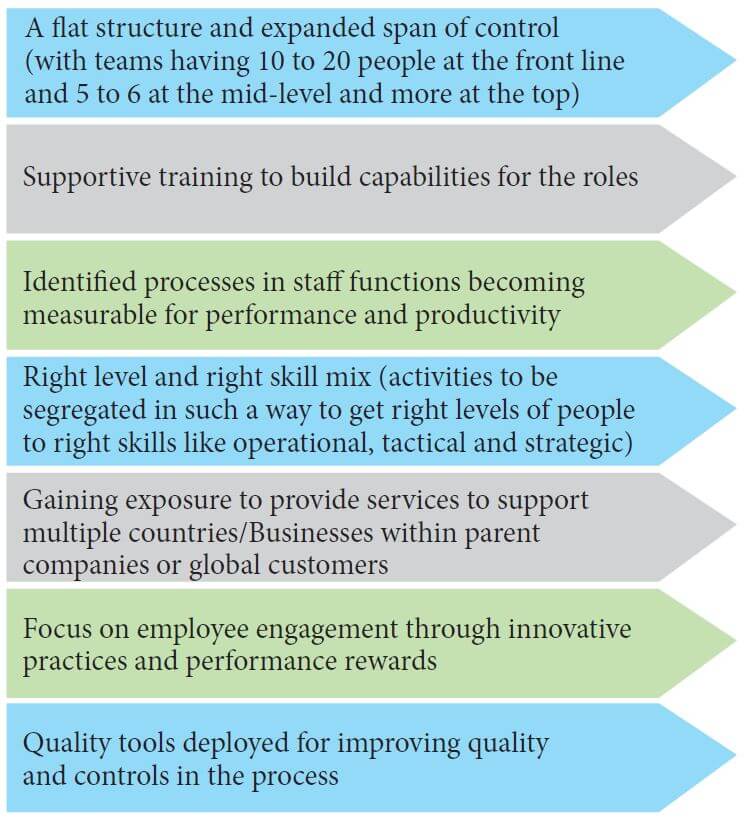
The Indian companies that have commenced their journey of BPM have started to make many of these changes, though at a slower speed. The great challenge is that many companies in India Inc. still believe that the old management practices can continue for the big management functions like F&A, HR etc., and time is not yet ripe for them to adopt BPM in a structured way, until it becomes a burning platform!
This is one of the areas where the Business Processes and Capabilities combine together to provide the right momentum. BPM needs to become a ‘culture’ for the strategy to be successful, as indicated below:
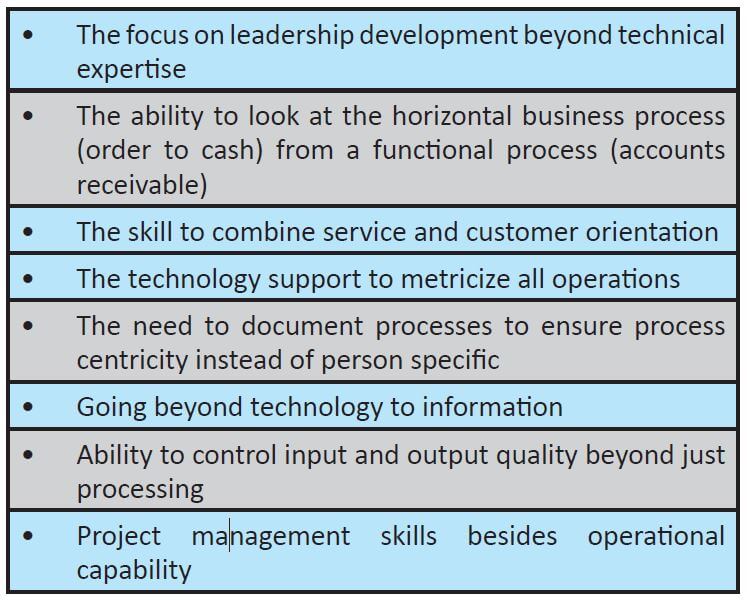
...and the list goes on…. This is just to show the interconnection of capability innovation to leapfrog the old management practices and conventional wisdom of managing resources, processes and technology.
With the global BPM organizations in India, the old management practices are being continuously questioned to be applicable in the new world of globalization and IT advancements.
There is huge inertia in this regard, and this will call for greater knowledge sharing among Indian corporations and the senior leadership preparing to spearhead the change!
Embracing Digital Economy
This is one area where changes have started happening for Indian Organizations which have commenced adoption of BPM strategy. CFOs and CIOs are driving this agenda jointly or individually although the investments are taking time. The good news about this requirement is that there are many types of models that have emerged which can give Indian Companies technology as they use, rather than committing investments upfront.
BPM will continue to be a great springboard to innovation and growth, with the right focus on the ‘strategy and culture’ surrounding BPM for achieving ‘evolutionary advantage’!
BPM is eventually IT Enabled Services. The biggest challenge in technology is NOT to be short term oriented, but to provide a direction to bring technology as part of the BPM strategy when drawn up - both in terms of leveraging existing technology as well as introducing simple bolt-on tools to speed up the process of transition and transformation.
Global organizations in India are surely showing the way, and it is important for the Indian organizations to learn and adopt what is best in the context of India.
Creating Opportunities for Developing World
India is an emerging economy and is very much part of the developing world. India has surely become the global hub for BPM. There is a lot of urbanization happening in India. Large population of India still lives in villages generating very low proportion of GDP, with ills of unemployment and disguised employment. India is a land of multiple languages. And BPM is not just about benefiting corporates but is also becoming part of the corporate social responsibility to develop India as a top economy.
Hence, the BPM adoption and impact has to reach the length and breadth of India, beyond even the Tier 3 cities! The power of BPM in India as a developing world, therefore, needs to combine with IT and Capability building with BPM. Several rural centres and BPOs have come up in villages – two stellar examples are Rural Shores as a new venture as well as a large corporation like Tata Business Support Services. They have located their operations at rural centres with supportive training given with the right type of processes to be carried out. While there are several corporates who are willing to support these centres, this support needs to go up in the next few years.
Again, the issue here is inertia to adopt and adapt villages as part of this journey. With connectivity anywhere, this is possible, if people are trained. And, the Indian Government with the ‘Make in India’ vision, provides continued focus on reforms, skill development, literacy and digital India.
India has both the potential and opportunity to become a top economy. As Christine Lagarde, the IMF Chief recently said, “India is a bright spot in the global economy, and the economic development holds much promise. I believe India has an opportunity to emerge as one of the world’s most dynamic economies and my message during this visit here will be: Seize it!”
Moving Forward: Inertia to Innovation in BPM
As we look at the big picture of ‘Rising Above Inertia’, it makes it important to leave some thoughts on moving from ‘inertia to innovation’, for reflection and review by the leaders of the Industry. Shared Services Forum (SSF) has evolved a simple “4 I” approach to innovation and transformation in BPM –
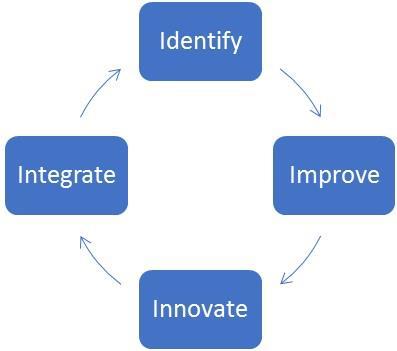
From the Indian economy point of view, it is worth reiterating that the growth in services sector has made all the difference to India’s growth and, IT and BPM are an integral part of this journey. Make in India strategy is not just focused on manufacturing but also on the services sector. It is, therefore, needless to mention that BPM will continue to be a great springboard to innovation and growth, with the right focus on the ‘strategy and culture’ surrounding BPM for achieving what Gary Hamel refers to as ‘evolutionary advantage’! The strategy will include leveraging the IT Revolution and Business Process focus by the India Inc, while the culture will include focus on human potential of India with the right skill, training and capability building not just to the urban population but also engaging the rural India to be part of this next journey. In 1991, we had a crisis that created the trigger. In 2015, the burning platform has to be self-created by all stakeholders of the Indian economy, and not just the Government.
It will be a great opportunity to continue this dialogue with the CXOs, BPM leaders and practitioners to build a powerhouse of knowledge sharing and put together a road map for making India truly one of the top economies of the World, and convert the potential of 5x times growth in GDP into a reality.
ABOUT THE AUTHOR
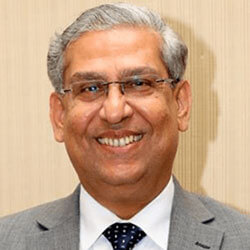
Ravi S Ramakrishnan is a seasoned business and people leader with invaluable experience of 35 years in finance, business and business process areas. He was instrumental in setting up the pioneering global offshoring operations at American Express. Having held leadership positions earlier in Hindustan Unilever, Murugappa Group and Eicher with CXO level responsibilities,
Ravi is recognized as a thought leader in off shoring and business process domains. He uniquely combines exposure to multiple sectors of Indian and global corporations and drives the vision and strategies for growth of RvaluE in the niche area of business process services through a team of professionals. Ravi is a Chartered & Cost Accountant and a Company Secretary.




